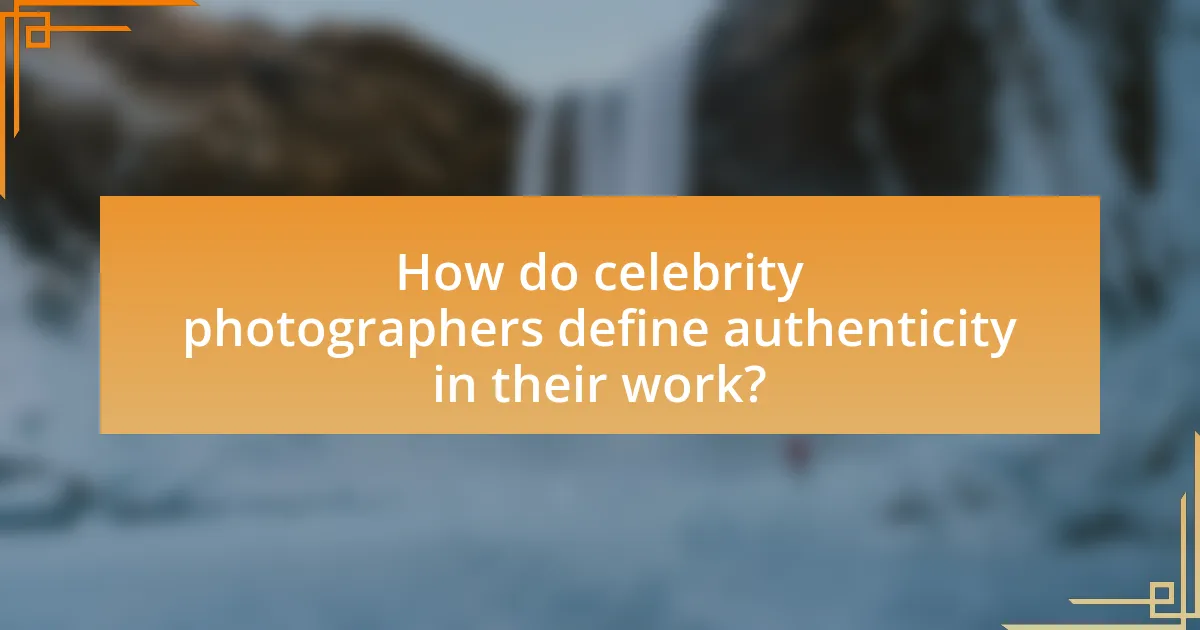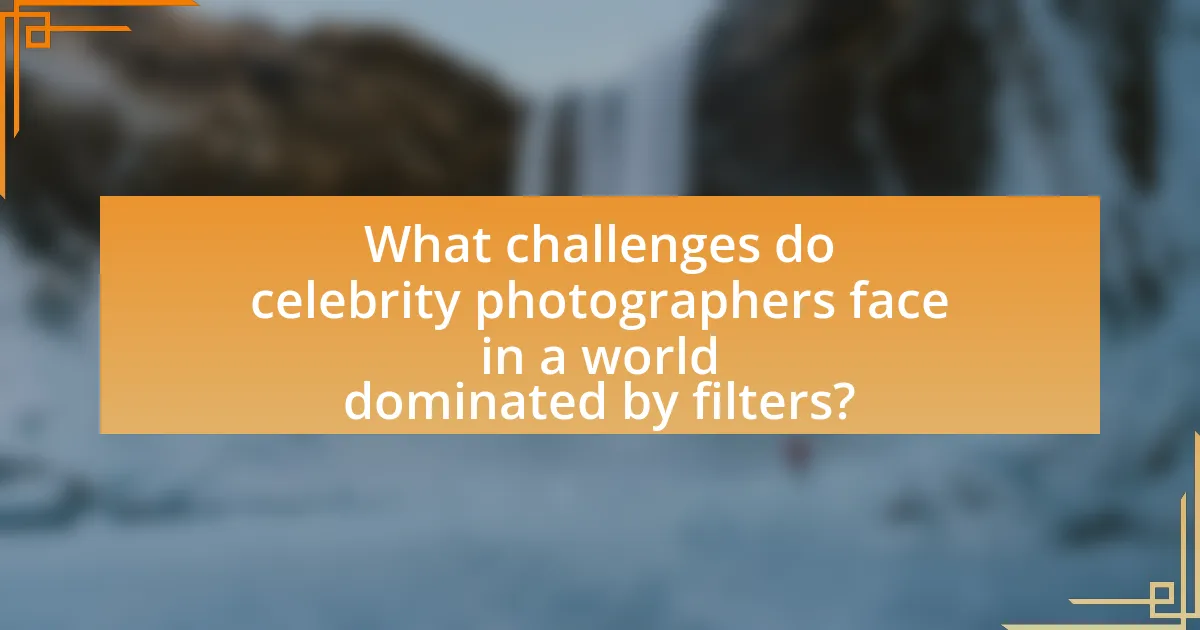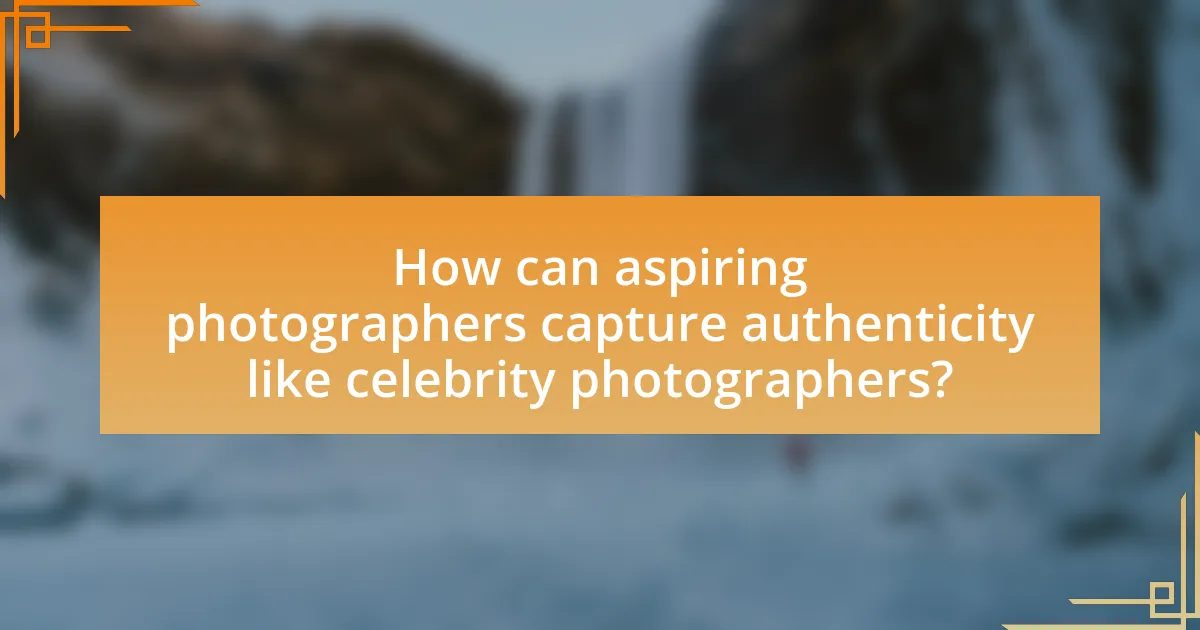Celebrity photographers prioritize authenticity by capturing genuine representations of their subjects, often through candid shots that reveal true emotions and personalities. Techniques such as natural lighting and emotional engagement are essential in portraying real moments, contrasting with the heavily edited images prevalent in today’s media landscape. The article explores the significance of authenticity in celebrity photography, its impact on public perception and fan relationships, and the challenges photographers face in a world dominated by filters. Additionally, it provides practical tips for aspiring photographers on how to enhance authenticity in their work, emphasizing the importance of building rapport with subjects and utilizing natural settings.

How do celebrity photographers define authenticity in their work?
Celebrity photographers define authenticity in their work as the genuine representation of their subjects, capturing unfiltered moments that reflect true emotions and personalities. This approach often involves candid shots that reveal the real-life experiences of celebrities, contrasting with staged or overly edited images. For instance, renowned celebrity photographer Annie Leibovitz emphasizes the importance of storytelling in her portraits, aiming to showcase the essence of her subjects rather than a polished facade. This commitment to authenticity resonates with audiences, as it fosters a deeper connection between the viewer and the celebrity, highlighting the human side behind the public persona.
What techniques do they use to capture genuine moments?
Celebrity photographers use techniques such as candid shooting, natural lighting, and emotional engagement to capture genuine moments. Candid shooting allows photographers to document subjects in their natural state, often resulting in more authentic expressions and interactions. Natural lighting enhances the realism of the images, avoiding the artificiality that can come from studio setups. Emotional engagement involves building rapport with the subjects, which encourages them to relax and be themselves, further contributing to the authenticity of the captured moments. These methods are supported by the understanding that genuine emotions resonate more with audiences, making the photographs relatable and impactful.
How does natural lighting influence the authenticity of a photograph?
Natural lighting significantly enhances the authenticity of a photograph by providing a natural color palette and dynamic shadows that reflect real-world conditions. This type of lighting captures the true essence of the subject, allowing for more genuine expressions and interactions, which are crucial for conveying emotion and context. Studies have shown that photographs taken in natural light often exhibit a higher level of detail and texture, making them more relatable and believable to viewers. For instance, a study published in the Journal of Visual Communication in Medicine found that images with natural lighting were perceived as more authentic compared to those with artificial lighting, reinforcing the idea that natural light plays a vital role in the authenticity of photographic representation.
What role does candid photography play in portraying real emotions?
Candid photography plays a crucial role in portraying real emotions by capturing spontaneous moments that reflect genuine feelings and interactions. Unlike posed photography, which often involves artificial expressions, candid shots reveal the subject’s true emotional state, providing an authentic glimpse into their experiences. Research indicates that images taken in natural settings, without the influence of staging or direction, evoke stronger emotional responses from viewers, as they resonate with the rawness of human experience. This authenticity is particularly significant in the context of celebrity photography, where the contrast between curated public personas and private realities can be stark, making candid images a powerful tool for revealing the truth behind the facade.
Why is authenticity important in celebrity photography?
Authenticity is important in celebrity photography because it fosters a genuine connection between the celebrity and their audience. When photographs capture real moments and emotions, they resonate more deeply with viewers, enhancing relatability and trust. Research indicates that audiences are increasingly drawn to unfiltered, candid images, as evidenced by the rise of social media platforms where authenticity is valued over perfection. For instance, a study by the Pew Research Center found that 64% of social media users prefer content that feels real and unedited, highlighting the demand for authenticity in visual representation. This connection not only boosts the celebrity’s image but also influences public perception and engagement.
How does authenticity affect public perception of celebrities?
Authenticity significantly enhances public perception of celebrities by fostering trust and relatability. When celebrities present themselves genuinely, they are often viewed as more approachable and credible, which can lead to increased fan loyalty and engagement. Research indicates that audiences are more likely to support and connect with public figures who exhibit authentic behavior, as seen in studies showing that 70% of consumers prefer brands that are transparent and genuine. This connection is crucial in an era dominated by curated images and social media filters, where authenticity stands out and resonates with audiences seeking realness.
What impact does authenticity have on the relationship between celebrities and their fans?
Authenticity significantly enhances the relationship between celebrities and their fans by fostering trust and emotional connection. When celebrities present themselves genuinely, fans are more likely to feel a sense of relatability and loyalty, which can lead to increased engagement and support. Research indicates that 70% of fans prefer celebrities who are perceived as authentic, as this perception can lead to stronger fan communities and increased social media interaction. This connection is crucial in an era dominated by curated images and filters, where authenticity serves as a counterbalance, allowing fans to feel more connected to the real person behind the public persona.

What challenges do celebrity photographers face in a world dominated by filters?
Celebrity photographers face significant challenges in a world dominated by filters, primarily the difficulty of capturing authentic moments amidst heavily edited images. The prevalence of filters alters public perception of beauty and reality, leading to unrealistic expectations for both celebrities and photographers. This environment pressures photographers to produce images that stand out while remaining true to the subject’s natural appearance. Additionally, the rise of social media platforms, where filtered images are the norm, complicates the photographer’s role, as they must navigate the balance between artistic integrity and audience expectations. The challenge is further compounded by the fact that many celebrities now curate their own images, often prioritizing filtered content over raw, unedited photography, which can diminish the demand for authentic representations.
How do filters alter the perception of authenticity in photography?
Filters significantly alter the perception of authenticity in photography by enhancing or manipulating visual elements, which can create a sense of artificiality. When photographers apply filters, they often change colors, contrast, and textures, leading viewers to question the true representation of the subject. Research indicates that images processed with filters can evoke emotional responses that differ from unaltered photographs, as seen in a study published in the journal “Psychological Science,” which found that edited images are often perceived as more aesthetically pleasing but less genuine. This manipulation can lead audiences to perceive filtered images as curated or staged rather than authentic, impacting how they connect with the subject matter.
What are the psychological effects of filtered images on audiences?
Filtered images can lead to negative psychological effects on audiences, including decreased self-esteem and increased body dissatisfaction. Research indicates that exposure to idealized and altered images can create unrealistic beauty standards, which in turn can contribute to feelings of inadequacy among viewers. A study published in the journal “Body Image” found that individuals who frequently engage with filtered images report higher levels of body dissatisfaction and lower self-esteem compared to those who do not. This phenomenon is exacerbated by social media platforms that promote these images, reinforcing the belief that such appearances are the norm.
How do photographers combat the trend of over-editing in their work?
Photographers combat the trend of over-editing by prioritizing authenticity and natural aesthetics in their work. They achieve this by using minimal editing techniques, focusing on capturing genuine moments rather than altering images extensively. For instance, many photographers adopt a philosophy of “less is more,” which emphasizes the importance of the original scene and the emotions it conveys. This approach is supported by the growing demand for unfiltered and relatable content on social media platforms, where audiences increasingly value authenticity over perfection.
What strategies do photographers employ to maintain authenticity?
Photographers maintain authenticity by focusing on genuine moments, utilizing natural lighting, and fostering trust with their subjects. By capturing candid interactions and emotions, photographers create images that reflect true experiences rather than staged scenarios. Natural lighting enhances the realism of photographs, avoiding the artificiality often associated with heavy editing. Additionally, building rapport with subjects encourages them to express their true selves, resulting in more authentic representations. These strategies collectively help photographers produce work that resonates with viewers, distinguishing it from heavily filtered or manipulated images.
How do they balance artistic expression with the need for authenticity?
Celebrity photographers balance artistic expression with the need for authenticity by employing techniques that highlight genuine moments while maintaining a creative vision. They often utilize natural lighting and candid shooting styles to capture subjects in their true form, which enhances the authenticity of the image. For instance, renowned photographer Annie Leibovitz emphasizes the importance of storytelling in her work, blending artistic elements with real-life narratives to create compelling portraits that resonate with viewers. This approach not only showcases the subject’s personality but also aligns with the audience’s desire for relatable and unfiltered representations.
What role does collaboration with celebrities play in achieving authentic images?
Collaboration with celebrities plays a crucial role in achieving authentic images by leveraging their influence and relatability to create genuine connections with audiences. When celebrity photographers work with well-known figures, they can capture moments that resonate emotionally, as these celebrities often embody aspirational qualities that audiences admire. Research indicates that 70% of consumers are more likely to trust a brand when it collaborates with a celebrity they admire, highlighting the effectiveness of such partnerships in enhancing authenticity. This collaboration allows photographers to present a more relatable and humanized portrayal of celebrities, moving beyond the polished images typically associated with fame.

How can aspiring photographers capture authenticity like celebrity photographers?
Aspiring photographers can capture authenticity like celebrity photographers by focusing on genuine moments and emotions rather than staged poses. Celebrity photographers often build rapport with their subjects, allowing for natural interactions that reveal true personalities. For instance, Annie Leibovitz is known for her ability to create intimate settings that encourage subjects to express themselves authentically, resulting in powerful imagery. Additionally, using natural light and candid shooting techniques can enhance the authenticity of the photographs, as seen in the work of photographers like Mario Testino, who often captures spontaneous moments that resonate with viewers.
What practical tips can help photographers enhance authenticity in their work?
Photographers can enhance authenticity in their work by focusing on genuine moments, using natural light, and engaging with their subjects. Capturing genuine moments involves being present and ready to photograph spontaneous interactions, which often reveal true emotions. Utilizing natural light helps create a more organic feel in images, as artificial lighting can sometimes create a staged appearance. Engaging with subjects fosters trust and comfort, allowing for more candid expressions and interactions, which contribute to a more authentic representation. These practices align with the principles of documentary photography, which emphasizes real-life situations and emotions, reinforcing the authenticity of the captured images.
How can photographers develop a unique style that emphasizes authenticity?
Photographers can develop a unique style that emphasizes authenticity by focusing on genuine moments and personal storytelling. This approach involves capturing subjects in their natural environments and allowing their true personalities to shine through, rather than relying on posed or heavily edited images. Research indicates that authenticity in photography resonates more with audiences, as seen in the work of renowned photographers like Annie Leibovitz, who often portrays her subjects in candid, relatable situations. By prioritizing real emotions and experiences, photographers can create a distinctive style that reflects their individual perspectives while connecting deeply with viewers.
What are the best practices for engaging with subjects to capture genuine moments?
The best practices for engaging with subjects to capture genuine moments include building rapport, being patient, and creating a comfortable environment. Building rapport involves establishing trust and connection, which encourages subjects to relax and be themselves. Patience allows photographers to wait for spontaneous moments to unfold naturally, rather than forcing poses. Creating a comfortable environment, whether through familiar settings or casual interactions, helps subjects feel at ease, leading to more authentic expressions. Research indicates that when subjects feel comfortable, they are more likely to display genuine emotions, enhancing the authenticity of the captured moment.
What resources are available for learning about authentic photography techniques?
Resources for learning about authentic photography techniques include online courses, photography books, and workshops. Online platforms like MasterClass and Skillshare offer courses taught by renowned photographers, focusing on capturing genuine moments. Books such as “The Art of Photography” by Bruce Barnbaum provide foundational knowledge and techniques for authenticity. Additionally, workshops led by professional photographers often emphasize hands-on experience and real-world applications, allowing learners to practice authentic photography in various settings. These resources collectively enhance understanding and skills in capturing authenticity in photography.
Which online courses or workshops focus on authenticity in photography?
Online courses and workshops that focus on authenticity in photography include “The Art of Authentic Photography” offered by CreativeLive and “Authentic Portraiture” by MasterClass. These programs emphasize capturing genuine moments and emotions, teaching techniques that help photographers move beyond staged or overly edited images. CreativeLive’s course, for instance, features industry professionals who share insights on storytelling through photography, while MasterClass provides lessons from renowned photographers who focus on real-life subjects and settings.
How can photographers find mentorship opportunities with established celebrity photographers?
Photographers can find mentorship opportunities with established celebrity photographers by actively engaging in industry events, workshops, and online platforms where these professionals are present. Networking at photography conferences, participating in masterclasses, and joining photography associations can facilitate connections with celebrity photographers who may offer mentorship. Additionally, utilizing social media platforms like Instagram and LinkedIn to follow and interact with these photographers can lead to potential mentorship opportunities, as many established professionals are open to guiding emerging talent.



